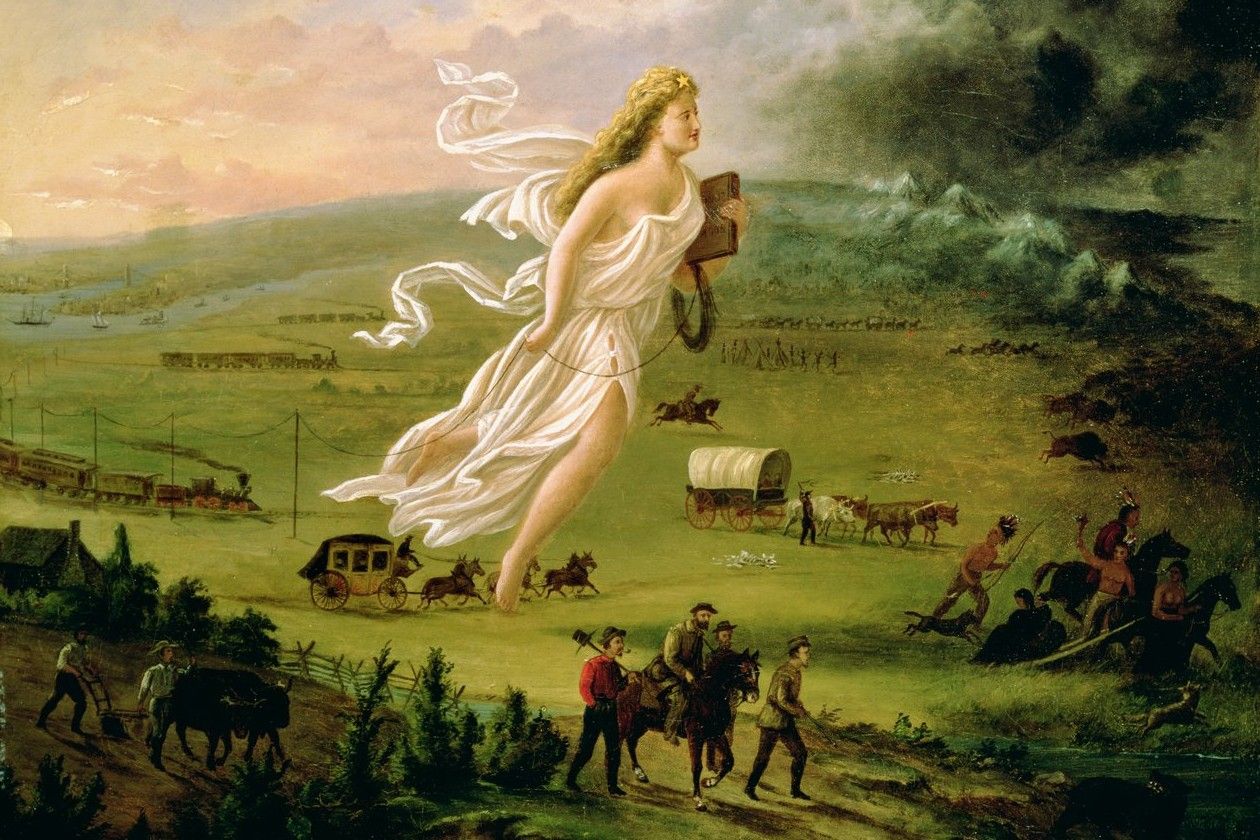
"American Progress" by John Gast is a painting that captures the spirit of Manifest Destiny, a 19th-century belief that the United States was destined to expand across North America. This iconic artwork, created in 1872, features a female figure named Columbia, symbolizing the United States, moving westward. She carries a schoolbook and telegraph wire, representing education and communication. As she advances, indigenous people and wildlife retreat into the shadows, highlighting the era's controversial push for expansion. The painting also showcases pioneers, railroads, and covered wagons, illustrating the technological and societal changes of the time. Understanding "American Progress" offers a glimpse into the mindset and motivations that shaped the nation's history.
The Painting and Its Creator
"American Progress" by John Gast is an iconic piece of art that encapsulates the spirit of Manifest Destiny. This painting, created in 1872, is filled with symbolism and historical significance.
- John Gast, a Prussian-born painter, created "American Progress" in 1872.
- The painting was commissioned by George Crofutt, a publisher of western travel guides.
- "American Progress" measures 12 ¾ inches by 16 ¾ inches, making it relatively small.
- The painting is an allegorical representation of Manifest Destiny, the 19th-century belief that Americans were destined to expand across the continent.
Symbolism in the Painting
The painting is rich with symbols that represent various aspects of American expansion and progress. Each element in the artwork tells a part of the story.
- The central figure is a woman named Columbia, a personification of the United States.
- Columbia is depicted carrying a schoolbook, symbolizing education and enlightenment.
- She also holds telegraph wire, representing technological advancement.
- The light surrounding Columbia signifies the spread of civilization.
- Native Americans and wild animals are shown retreating westward, symbolizing the displacement caused by expansion.
Historical Context
Understanding the historical context of "American Progress" provides deeper insight into its meaning and significance.
- The painting was created during the post-Civil War era, a time of rapid westward expansion.
- The Transcontinental Railroad, completed in 1869, is depicted in the painting, highlighting its importance in connecting the country.
- The Gold Rush, which began in 1848, is another event alluded to in the artwork.
- The Homestead Act of 1862, which encouraged western migration by providing settlers with land, is also reflected in the painting.
Impact and Legacy
"American Progress" has left a lasting impact on American culture and continues to be a subject of study and discussion.
- The painting has been widely reproduced in textbooks, reinforcing its iconic status.
- It has been used to illustrate the concept of Manifest Destiny in educational materials.
- "American Progress" has sparked debates about the consequences of westward expansion, including the treatment of Native Americans.
- The painting is often cited in discussions about American exceptionalism and national identity.
Artistic Techniques
John Gast employed various artistic techniques to convey his message effectively.
- The use of light and dark contrasts emphasizes the theme of civilization versus wilderness.
- Gast's detailed depiction of the landscape showcases the vastness and diversity of the American frontier.
- The composition directs the viewer's eye from east to west, mirroring the direction of American expansion.
- The inclusion of various modes of transportation, such as covered wagons and trains, highlights technological progress.
Criticisms and Controversies
While "American Progress" is celebrated for its artistic and historical significance, it has also faced criticism.
- Critics argue that the painting romanticizes westward expansion and overlooks the suffering of Native Americans.
- Some view the painting as a form of propaganda that justified the displacement of indigenous peoples.
- The portrayal of Native Americans as fleeing and uncivilized has been criticized for perpetuating stereotypes.
- Despite these criticisms, "American Progress" remains a valuable artifact for understanding 19th-century American values and beliefs.
The Last Word on American Progress
"American Progress" by John Gast isn't just a painting; it's a snapshot of a pivotal time in U.S. history. This artwork captures the spirit of Manifest Destiny, showing how Americans viewed their expansion westward as a mission of progress and civilization. The painting's symbolism, from the angelic figure to the advancing settlers, tells a story of ambition and transformation.
Understanding this piece helps us grasp the mindset of 19th-century America. It reflects the optimism and determination of a nation on the move, but also reminds us of the complex and often harsh realities faced by Native Americans and the environment.
So, next time you see "American Progress," remember it's more than just a pretty picture. It's a window into the hopes, dreams, and challenges of a growing nation. Keep exploring history; there's always more to learn!
Was this page helpful?
Our commitment to delivering trustworthy and engaging content is at the heart of what we do. Each fact on our site is contributed by real users like you, bringing a wealth of diverse insights and information. To ensure the highest standards of accuracy and reliability, our dedicated editors meticulously review each submission. This process guarantees that the facts we share are not only fascinating but also credible. Trust in our commitment to quality and authenticity as you explore and learn with us.
